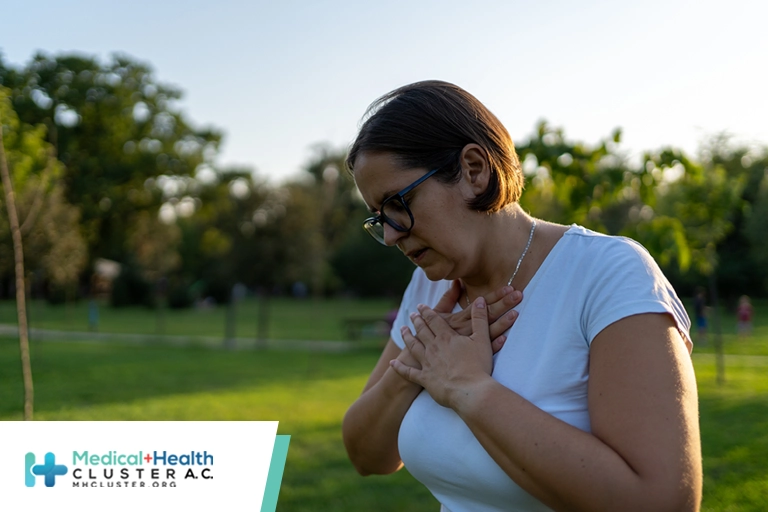7 días en 7 noticias, 1 cifra y 1 frase:...
Leer más
Large Cohort Study Finds Possible Association Between Postural Orthostatic Tachycardia Syndrome and COVID-19 Vaccination but Far Stronger Link With SARS-CoV-2 Infection

Shortly after COVID-19 vaccines first became available, Tae Chung, MD, noticed something unusual at the Johns Hopkins Postural Orthostatic Tachycardia Syndrome (POTS) program, which he directs.
Seven patients newly diagnosed with POTS were either medical students or physicians. They had no recent history of SARS-CoV-2 infection, which, research has suggested, is associated with an increased risk of POTS. The autonomic disorder commonly occurs after a viral or bacterial infection and is characterized by brain fog, fatigue, and lightheadedness and increased heart rate upon standing—symptoms also seen in people with postacute sequela of COVID-19 (PASC).
Because the patients were health care workers, they were among the first to be vaccinated against the novel coronavirus, leading Chung to wonder whether POTS could be linked to COVID-19 vaccination in addition to SARS-CoV-2 infection.
Eventually, a few case reports appeared in the medical literature, from Japan, Korea, and the US, about new-onset POTS in previously healthy people who’d recently received a messenger RNA (mRNA) COVID-19 vaccine. But these were only 3 reported cases out of hundreds of millions of vaccine doses administered, far too few on which to base any conclusions.
This past December, however, a large cohort study identified a possible association between COVID-19 vaccination and POTS as well as a much stronger link between SARS-CoV-2 infection and POTS.
“I’m really excited this paper came out,” Chung, who wasn’t involved in the study, said in an interview. “It really confirms my long suspicion.”
The Need for Self Control(s)
The study, published in Nature Cardiovascular Research, analyzed electronic health records (EHR) data for outpatient encounters by nearly 285 000 individuals who’d received COVID-19 vaccines—93% of them an mRNA vaccine—at Cedars Sinai Medical Center in Los Angeles. “We were the vaccination center for a large portion of Los Angeles,” first author Alan Kwan, MD, explained in an interview.
In a summary of their study, Kwan and coauthor Susan Cheng, MD, both of the Cedars Sinai Smidt Heart Institute, acknowledged the challenges of trying to assess the relationship between COVID-19 vaccination and newly diagnosed POTS.
“This type of analysis is inherently difficult owing to the lack of ideal controls, multiple confounding factors related to the context of the pandemic and the effect of COVID-19 vaccination on patients’ engagement with the healthcare system,” they wrote.
So they took a page from pharmacoepidemiology studies in which patients serve as their own controls. Kwan and his collaborators compared patients’ odds of a POTS-related diagnosis—including POTS as well as fatigue, dysautonomia, mast cell disorders, and Ehlers-Danlos syndrome—for 90 days before vaccination with their odds during the 90 days after vaccination. And to account for the possibility of increased engagement with the health care system after vaccination, they compared the incidence of POTS-related diagnoses with the incidence of common primary care diagnoses that aren’t POTS related, such as urinary tract infections and gastroesophageal reflux disease.
The study design could be particularly useful for EHR-type cohorts in which limited data elements could impede controlling for confounders, Sean Coady, MA, a statistician in the National Heart, Lung, and Blood Institute (NHLBI) epidemiology branch, wrote in an email to JAMA. “The approach of using an individual as their own control has significant appeal” because it minimizes confounders that aren’t time-dependent, such as genetics, explained Coady, a program official for one of the study’s NHLBI grants.
A total of 4526 POTS-related diagnoses were made among the cohort members, with 2581 of them made after vaccination. This meant the odds of a POTS-related diagnosis were 33% higher after vaccination than before. In comparison, the odds of a diagnosis not related to POTS were 21% higher after vaccination than before.
After vaccination, the odds of a POTS-related diagnosis were 10% higher than the odds of a diagnosis not related to POTS. The authors noted that only 25 new cases of myocarditis, the best-characterized COVID-19 vaccine adverse event, occurred in the cohort, 7 before vaccination and 18 after.
The researchers also conducted a separate analysis of 12 460 patients with confirmed SARS-CoV-2 infection, none of whom had received a COVID-19 vaccine within 90 days before or after their diagnosis. A total of 1004 POTS-related diagnoses were made in this group, 605 of them after having COVID-19, making the odds of a POTS-related diagnosis after SARS-CoV-2 infection more than 5 times greater than after COVID-19 vaccination, the authors reported.
Given that POTS is known to be one of the PASC syndromes, it is biologically plausible “for a similar, even if attenuated, systemic response to vaccine,” Kwan and his coauthors wrote.
Interestingly, Kwan noted, although POTS in general is much more common among women, his study found the incidence to be similar in women and men. He said it’s unclear whether POTS associated with COVID-19 vaccination or SARS-CoV-2 infection is different from other POTS cases.
The study “is of major importance to POTS research and patient care,” neurologist Svetlana Blitshteyn, MD, a clinical associate professor at the University of Buffalo’s Jacobs School of Medicine and Biomedical Sciences, and Karolinska Institute cardiologist Artur Fedorowski, MD, PhD, wrote in an accompanying editorial. “[I]t undeniably establishes POTS and dysautonomia in general as adverse events after vaccination that should be recognized and investigated as other well-accepted post-vaccination syndromes.”
An Overestimation?
Kwan is the first to acknowledge that his study isn’t the final word on a possible relationship between COVID-19 vaccination and POTS. “I hope that this research spurs more research,” he emphasized.
In an email to JAMA, Jesse Goodman, MD, MPH, called Kwan’s article “provocative” but not conclusive. Using 90 days pre-vaccination as the control period, “while a valid approach, cannot, as the authors noted, eliminate confounding by unmeasured factors,” wrote Goodman, director of Georgetown University’s Center on Medical Product Access, Safety and Stewardship. “For example, if people tend to delay vaccination if they don’t feel well, that might make pre-vaccine period rates of any diagnoses, including POTS, artificially low, and, in comparison, make post-vaccine rates appear elevated.”
Goodman, an infectious disease specialist who formerly served as chief scientist at the US Food and Drug Administration, noted that the incidence of most diagnoses measured—not just those related to POTS—occurred more frequently after vaccination than before, further evidence, perhaps, that people who are unwell might postpone getting vaccinated until they feel better.
“Also, the overall rates of POTS seem high, even in the pre-vaccine or pre-COVID [infection] groups, when compared to what is in the literature,” Goodman noted. If the COVID-19 vaccines led to an excess of around 90 cases of POTS-related diagnoses per 100 000 individuals, as reported by Kwan’s team, “we might have expected to see a signal in the original controlled trials of [around] 15 000 to 20 000 or in post-authorization safety databases.” The evidence that SARS-CoV-2 infection causes POTS seems stronger, Goodman added.
Considering that the cohort’s average age was 52 years and that more than half its members were women, the overall rate of myocarditis also seemed high, Robert Bonow, MD, said in an interview. Myocarditis is seen most commonly in young men, explained Bonow, a cardiologist at the Northwestern Feinberg School of Medicine and editor of JAMA Cardiology.
Coady called the “fairly substantial” POTS-related incidence rate both before and after vaccination “somewhat surprising.” “[I]ndividuals may become more cognizant of certain symptoms of dysautonomia of the nervous system post-vaccination…given the relatively new vaccine, conflicting media reports, etc.,” he speculated. “Replication in other populations using a different study design, if possible, would be useful to confirm findings.”
A more precise approach to identify new POTS cases after vaccination would be to perform a diagnostic test for the condition before vaccination and then several weeks afterward, Coady said. One such test measures blood pressure and heart rate while lying down and then while standing for 10 minutes. A heart rate increase of at least 30 beats per minute, coupled with a drop in blood pressure of no more than 20 mm Hg, is characteristic of POTS.
The authors of the accompanying editorial pointed out that traditional POTS diagnostic criteria require that symptoms last at least 3 months—the same length of time assessed in Kwan’s study. That suggests that some of the people diagnosed with POTS or related diagnoses in the 90 days following vaccination might have been misdiagnosed and recovered later, leading to an overestimation of cases. However, Kwan explained, with a longer assessment period, the connection between vaccination and POTS would become hazier.
To assess the validity of their approach, he and his coauthors clinically adjudicated 50 sequentially encountered patients identified as having both unspecified cardiac arrythmia and unspecified disorder of the autonomic nervous system. They found that 40 of those patients (80%) either had been formally confirmed as having POTS through comprehensive diagnostic testing or had signs and symptoms consistent with guideline definitions of the condition but were still awaiting full diagnostic testing for confirmation. Notwithstanding those “acceptable results,” Kwan and his coauthors wrote, “we recognize that our analyses of EHR data are intrinsically subject to non-differential misclassification that generally tends to bias results toward the null.”
The editorialists noted that the reliability of POTS incidence data depends on awareness and diagnostic vigilance of the condition. Many patients with POTS experience lengthy delays in obtaining a diagnosis, research has found. “I think POTS is one of the conditions that’s been so misunderstood by a lot of doctors,” in part because it predominantly affects young women, Chung said. However, he added, “the COVID pandemic has definitely brought increased awareness” of POTS.
Responsible Messaging
Kwan said he worried that his findings might be exploited by people spreading vaccine disinformation. “I’d say we were concerned about responsible messaging,” he noted.
But the main feedback he’s received has been from patients who finally felt seen and heard, he said. They had developed POTS symptoms after COVID-19 vaccination but weren’t taken seriously when they suggested the 2 might be connected.
In medicine, “sometimes you make the correct choice, but bad things still happen,” Kwan said. “Good physicians have to be able to navigate that.”
As Chung pointed out, some people have developed Guillain-Barré syndrome (GBS), a rare neurological disorder, after receiving a flu shot, but research suggests that the odds of GBS are greater after an influenza infection.
Like flu vaccines, COVID-19 vaccines have protected countless individuals from sickness and death, so Chung said, “even if I thought there was maybe a causal relationship [with POTS], I’m not going to say don’t get the vaccine.”
Source: https://jamanetwork.com/journals/jama/fullarticle/2800964?guestAccessKey=1662d51d-7cbd-4851-a3f2-9f2ac9a38eaa&utm_source=fbpage&utm_medium=social_jama&utm_term=8898977945&utm_campaign=article_alert&linkId=201469417




